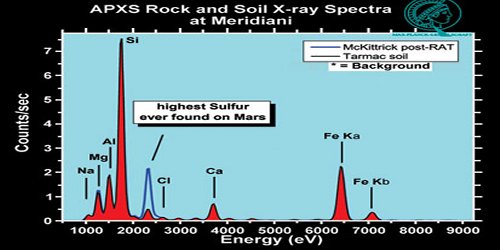Meridiani Planum: "Drenched"
Meridiani Planum: "Drenched"
−メリディアニ平原はかつて水に濡れていた−
March 2, 2004: Some rocks at Opportunity's landing site in Meridiani Planum on Mars were once soaked in liquid water. Members of the Mars Exploration Rovers' international science team presented the evidence today to news reporters at NASA Headquarters in Washington, DC.
2004年3月2日: オポチュニティの着陸地、メリディアニ平原の岩石は、かつて液体の水に浸かっていました。火星探査車の国際的科学チームのメンバーは今日ワシントンDCのNASAの本部において報道記者にその証拠を提示しました。
"Liquid water once flowed through these rocks. It changed their texture, and it changed their chemistry," said Cornell University's Steve Squyres, the principal investigator for the science instruments on Opportunity and its twin, Spirit. "We've been able to read the tell-tale clues the water left behind, giving us confidence in that conclusion."
「液体の水が以前これらの岩の間を流れていました。この水が岩石の表面を変化させ、化学組成を変化させたのです」とコーネル大学のスティーヴ・スクゥイアーズは述べました。彼はオポチュニティとスピリットの科学機器に関する主任研究員です。「私たちは、その水が残した証拠となる手掛かりを見つけ、その確証に至りました」
Here are some of the clues that water formerly pervaded an outcropping of rocks where Opportunity has been working:
以下に、オポチュニティが観察した岩石に残っていた、かつて液体の水が存在した証拠を述べます。
(1) The rover's alpha particle X-ray spectrometer found lots of sulfur in the outcrop. Related clues from that instrument and the miniature thermal emission spectrometer suggest the sulfur is in the form of sulfate salts (similar to Epsom salts). On Earth, rocks containing so much salt either formed in water or, after formation, were soaked in water a long time.
(1) ローバーのアルファ粒子X線分光計は露頭に多くの硫黄を見つけました。分光計と小型の熱放射分光計から得られた結果から、それらの硫黄が硫酸塩(エプソム塩に似ている)の形を取っていることを示唆しています。地球でこれほど多くの塩を含んでいる岩は水の中で生成されたか、あるいは生成後に、長期間水に浸かっていたことを示します。
Above: These spectra show that a rock dubbed "McKittrick" near the Mars Exploration Rover Opportunity's landing site at Meridiani Planum, Mars, possesses the highest concentration of sulfur yet observed on Mars. [ More]
これらのスペクトルは、Meridiani Planum、オポチュニティの着陸地の近くの「McKittrick」を観察した時のものです。火星でこれまで観察されたなかで、硫黄が最も大量に観測されました。[
詳細(未訳)]
(2) The rover's Moessbauer spectrometer detected jarosite, a hydrated iron sulfate mineral that could result from the target rock spending time in an acidic lake or acidic hot springs environment.
(2) ローバーのメスバウアー分光計はジャロサイトを検知しました。これは水和された硫酸鉄鉱物で、この岩石が長期間酸性湖の底にあったか酸性の温泉にあったことを示唆します。
(3) Pictures from Opportunity's panoramic camera and microscopic imager show many thin, flat holes--"about the size of pennies," says Squyres--in an outcrop rock selected for close-up examination. These holes, or "vugs," match the distinctive appearance of Earth-rock vugs that form where crystals of salt minerals grow inside rocks that sit in briny water then disappear by eroding or dissolving.
(3) オポチュニティのパノラマカメラおよび微細カメラの画像には、クローズアップ検査に選ばれた岩石において、多くの薄く水平な穴(スクゥイアーズが言うには「1セント銅貨ぐらい」)が写っていました。これらの穴は、塩水にさらされた岩石の内部で塩の結晶が成長し、その後、腐食するか解けることで生じる特殊な形状によく似ています。
(4) The cameras have revealed spheres the size of BBs embedded in outcrop rocks. Researchers call them "blueberries"-- although they're not blue, they're gray. The spherules are not concentrated at particular layers within the rock, as they would be if they originated outside the rock and were deposited onto accumulating layers while the rock was forming. Instead, the spherules are scattered. This means they are probably what geologists call "concretions" that formed from accumulation of minerals coming out of solution inside a porous, water-soaked rock.
(4)また、カメラには岩石に埋め込まれたBB(ボールベアリング?)ほどのサイズの球体が写っていました。研究者はこれらを「ブルーベリー」と呼んでいます(青くはありません、灰色です)。これらの球体は岩石の一部の層に集中していたのではなく、バラバラに存在していました。もし一部の層に集中していたならば、それはこれらの球体が岩石の外で形成され、岩石の形成過程で蓄積されたことを意味します。しかし、球体がバラバラに存在していたということは、水に浸かっていた多孔性の岩石内に閉じ込められた液体から生じたものであることを示唆します。これは地質学者が「凝結物(concretions)」と呼ぶものだと思われます。
(訳注)ある一定の地層でのみ「ブルーベリー」が発見されたならば、それは火山や隕石の衝突による一時的な現象と考えられますが、岩石内に一様に存在していたということは、岩石が生成する過程で生じ、長期間にわたり水が介在した可能性があることを示しています。
A spherule in a region of the rock outcrop dubbed "El Capitan." The area in this image, taken on Sol 28 of the Opportunity mission, is 1.3 centimeters (half an inch) across. [ Larger image]
この小球は「El Capitan」と呼ばれる岩石付近にありました。この画像に写っている範囲は対角線で1.3センチメートル(0.5インチ)です。この写真はオポチュニティによってソル28に撮影されました。[クリックで拡大]
(5) Some of the spherules in pictures from the microscope appear to have stripes that correspond to layering of the matrix rock around them. This would be consistent with the interpretation that the spherules are concretions that formed inside a wet rock.
(5) 顕微鏡で撮影された写真に写っていた小球のうちのいくつかは、母岩の地層に相当する縞を持つように見えます。これは、小球が水にさらされた岩石の内部で生じた凝結物であるという解釈と一致します。
There is still much to learn: When was the area wet? And how long did the wet conditions last? How was the water collected--e.g., in a salty lake or sea? How deep was the water? Scientists and engineers plan to keep Opportunity busy in the days ahead looking for more clues that might answer some of these questions.
まだ、学ぶべきことは沢山あります。そのエリアはいつ水にさらされていたか。また、その状態はどれくらいの時間続いたか。その水はどのような形で集まっていたか―塩気のある湖か海でしょうか。水は深さはどれくらいだったのか? 科学者とエンジニアは、オポチュニティを使ってこれらの疑問に答えうるより多くの手掛かりを捜す調査を続ける予定です。
Credits & Contacts
Source:
NASA press release
Responsible NASA official:
Ron Koczor
Production Editor:
Dr. Tony Phillips
Curator:
Bryan Walls
Media Relations:
Steve Roy
The Science and Technology Directorate at NASA's Marshall Space Flight Center sponsors the Science@NASA web sites. The mission of Science@NASA is to help the public understand how exciting NASA research is and to help NASA scientists fulfill their outreach responsibilities.
More Information
Mars Exploration -- (NASA/JPL) NASA's home page for exploration of the red planet
Rover Finds Signs of Wet Martian Past -- (NASA) NASA's Opportunity rover is showing indications that water once flowed on Mars.
Destination: Meridiani Planum -- (Science@NASA) On January 24, 2004, NASA's Mars rover Opportunity landed on a Martian plain in search of evidence for water.
Interplanetary Hole in One -- (Science@NASA) After traveling 300 million miles, Spirit's twin rover Opportunity landed on Mars in a small shallow crater--the perfect place to look for signs of ancient martian water.
The Case of the Missing Mars Water -- (Science@NASA) Plenty of clues suggest that liquid water once flowed on Mars --raising hopes that life could have arisen there-- but the evidence remains inconclusive and sometimes contradictory
Making a Splash on Mars -- (Science@NASA) On a planet that's colder than Antarctica and where water boils at ten degrees above freezing, how could liquid water ever exist? Scientists say a dash of salt might help.

